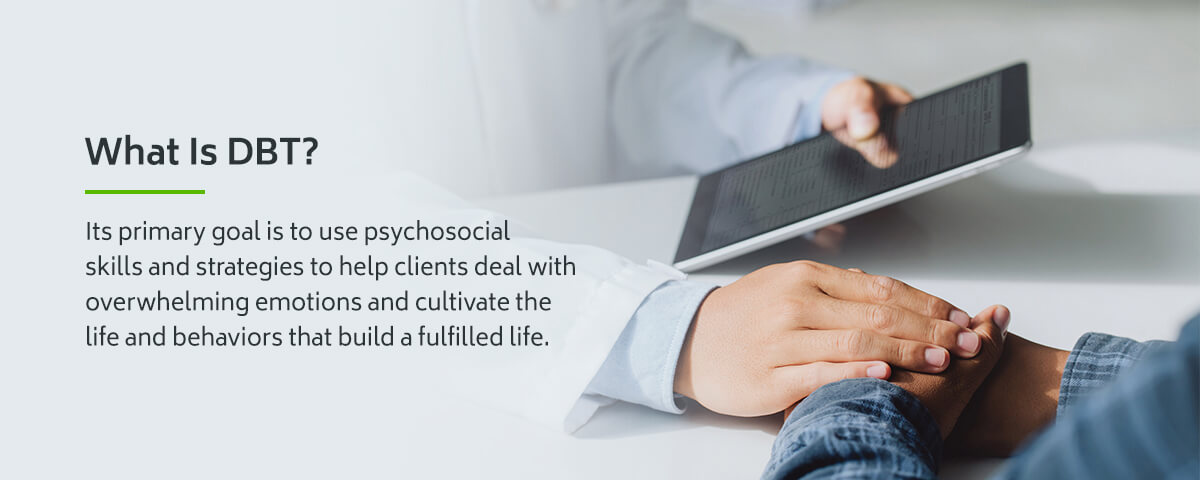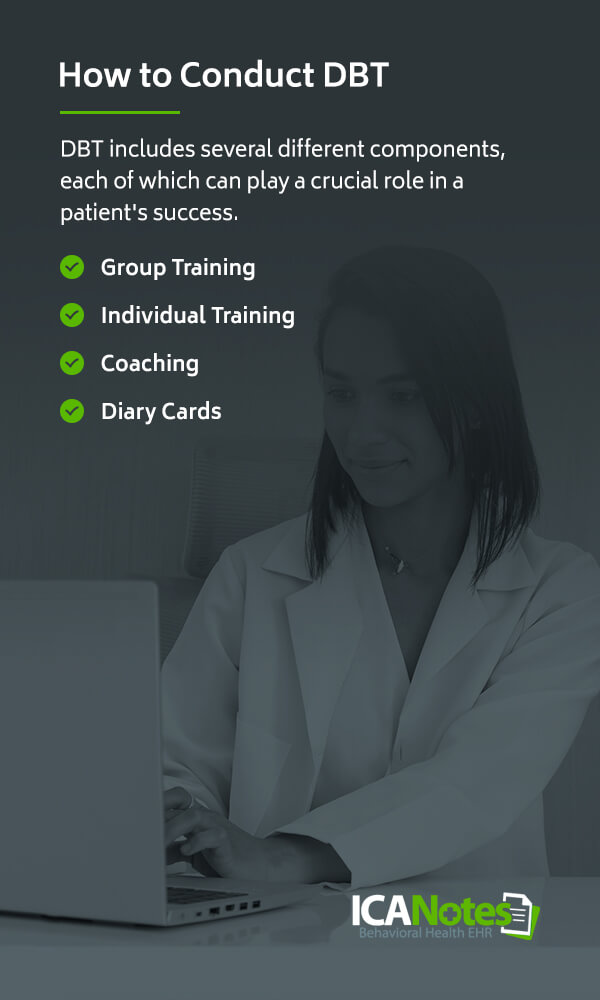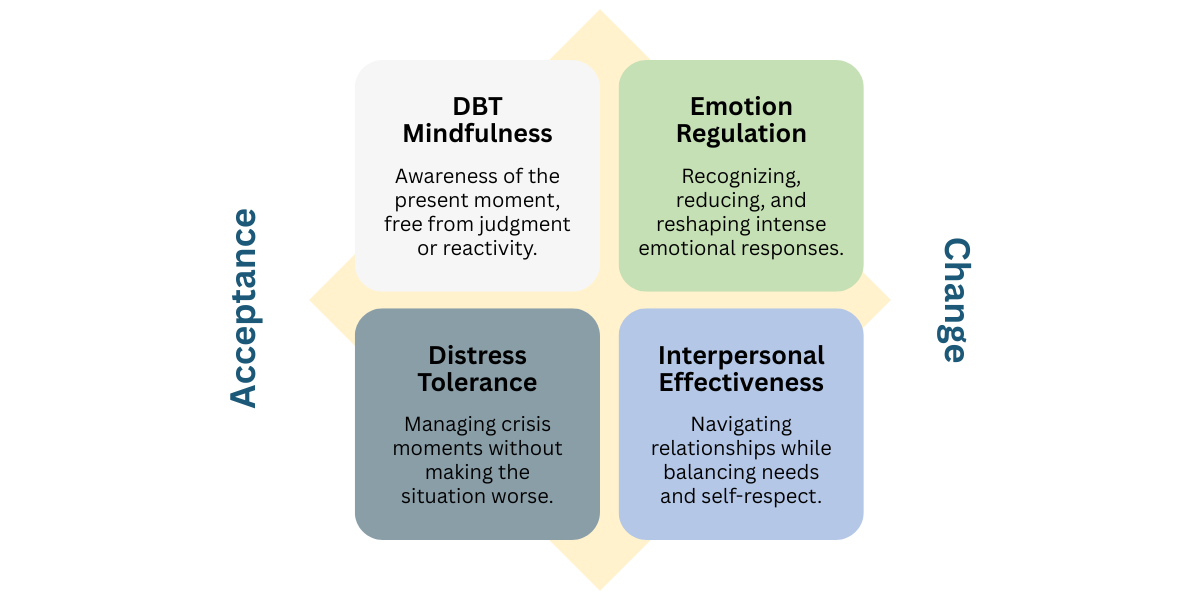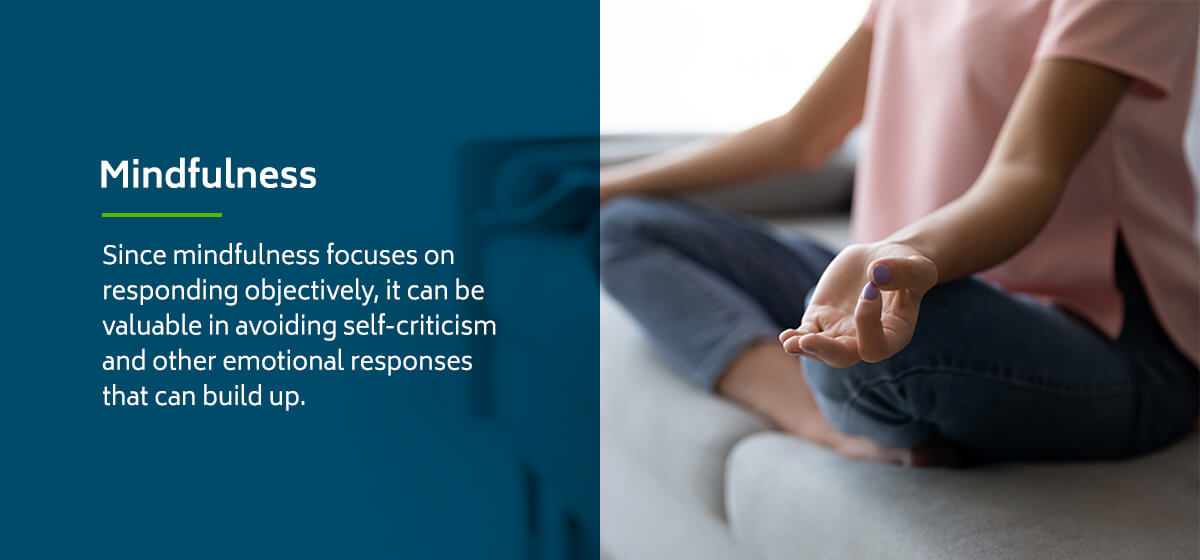Blog > Treatment Strategies > DBT Basics
DBT Basics: Tips and Techniques for Clinicians

Dr. October Boyles, DNP, MSN, BSN, RN
Last Updated: April 23, 2025


What You'll Learn
- The foundational principles of DBT and their application in clinical settings
- The four stages of DBT and how they guide the therapeutic process
- Key DBT skills, including mindfulness, distress tolerance, emotion regulation, and interpersonal effectiveness
- Practical techniques for implementing DBT strategies in both individual and group therapy sessions
- Methods for assessing client suitability for DBT and monitoring progress over time
DBT, sometimes called Dialectical Behavior Therapy, leans on acceptance and balance, which paves the way for lifelong changes. Clinicians can use DBT for a range of clients who deal with emotional dysregulation. In this DBT 101 post, we'll be discussing the basics of DBT and some tips for clinicians to make the most of this evidence-based treatment modality.
DBT is widely recognized as one of the most effective treatments for individuals diagnosed with Borderline Personality Disorder (BPD). It has also shown efficacy for other conditions, including: anxiety, depression, PTSD, and substance use disorders.
What Is DBT?
DBT is a form of cognitive behavioral therapy (CBT), both of which have been used for decades and are well-studied. DBT was initially created in the 1970s by Dr. Marsha Linehan to reduce suicidal thoughts, particularly for people with borderline personality disorder. Its primary goal is to use psychosocial skills and strategies to help clients deal with overwhelming emotions and cultivate the life and behaviors that build a fulfilled life.

Some guiding principles of DBT include recognizing that all things are interconnected, that opposites can be integrated to better approach truth and that change is constant and inevitable. DBT helps clients respond to their emotions in ways that are more conducive to reaching their goals than their initial behaviors. Those initial behaviors might include self-harm, suicidal thoughts, risky sexual behaviors or substance use. DBT can be a central component of treating disorders related to emotional regulation such as depression and anger problems.
If we break down the components of DBT, we can learn more about the approach:
- D: The D stands for "dialectical," which refers to the idea that two opposing ideas can both be true. For example, we can accept our current situation while striving to make it better. Finding balance and acceptance is a key part of the strategy.
- B: As with CBT, the B stands for "behavioral." DBT's goal is to establish and achieve target behaviors that align with one's goals by modifying the thoughts behind them.
- T: The "therapy" of DBT often occurs as a combination of individual sessions, group sessions and coaching. The clinician provides guidance, education and support.
DBT is an evidence-based practice that clinicians can use to show insurance providers the quality of care being offered. As a long-term treatment strategy, DBT also offers a way to demonstrate client improvement over time. When using DBT, clinicians should recognize the importance of a collaborative relationship with the client and support and skill development.
You've probably noticed similarities to CBT. DBT is a type of CBT, so both work on modifying thought patterns and behaviors. DBT, however, adds elements of humanism and dialectics to the program. Instead of primarily focusing on changing behaviors, DBT includes reflection, validation and support, so the client doesn't feel like their problems are all their fault or blame others for them. These were some of the unproductive responses to CBT that led Linehan to develop DBT for her BPD and suicidal patients.
DBT also looks closely at psychosocial problems, especially those that could disrupt relationships.
Teach and Reinforce DBT Interpersonal Skills with Confidence
Download our clinician guide to the DEAR MAN, GIVE, and FAST frameworks along with a ready-to-use client homework assignment that helps clients apply these skills in real-life situations.
What Is DBT Used For?
Many clinicians use DBT for patients who haven't responded well to medication or other therapeutic methods, though it's also an effective part of an initial treatment plan. It typically targets disorders and symptoms related to emotional regulation, such as:
- Self-harm
- Suicidal thoughts or attempts
- Substance misuse
- Eating disorders
- Post-traumatic stress
- Interpersonal problems
- Anger difficulties
- Anxiety
- Depression
These types of behaviors and symptoms usually occur as a response to overwhelming emotions, and DBT provides healthier coping mechanisms. DBT teaches the client to focus on solving problems in the immediate moment, without dwelling on the past, worrying about the future or blaming others for their situation. By improving their ability to deal with tough emotions, clients can stay grounded to make choices that better align with their goals.
DBT is effective across age ranges, genders, sexual orientations, countries, races and ethnicities.
What are the Stages of DBT?
DBT can be split up into four different stages of treatment. The first two stages focus more on the client's feelings, goals and current situation as they attempt to achieve stability and control emotions. The last two stages turn toward achieving value-driven goals. They take longer to enact but help the client make long-term changes and cultivate the life they want while maintaining stability and happiness.
The stages of DBT are as follows:
- Stage 1 - Achieving behavioral stability: In the first stage of DBT, clients often come to the therapist in a crisis state. The therapist helps to stabilize them with skills for gaining control of emotions in the short term. The therapist also needs to establish a safe environment and minimize behaviors that could interfere with the success of therapy.
- Stage 2 - Addressing emotional experiencing and trauma: Once the client is more stable, the therapist helps them explore causes of emotional pain, such as trauma and invalidating experiences. Since these discussions can be emotional, they should not occur until after stage 1, when the patient is stable.
- Stage 3 - Enhancing quality of life and improving day-to-day functioning: Now that the client has established healthier responses, the therapist can shift to maintaining them and setting reasonable goals toward happiness, stability and trust in oneself.
- Stage 4 - Developing deeper meaning, purpose, and sustained happiness: Finally, the client and therapist can focus on big-picture goals. They may focus on maintaining stability and happiness from the last step, along with spiritual fulfillment and valuable relationships.
Keep in mind that these stages aren't always chronological. Different issues may need to be revisited so a patient can drop back to an earlier stage to work through them.
How Long Does DBT Treatment Take?
DBT treatment can vary widely in length, but many programs last from six months to a year. It takes time to build up the skills needed and achieve stability. DBT programs often include both individual and group sessions each week. The length of a DBT program will, of course, depend on how quickly the client picks up on the skills and how much work they need to do.
What a Comprehensive DBT Program Includes
DBT includes several different components, each of which can play a crucial role in a patient's treatment.
Group DBT Training
In group DBT training, clients learn various skills and strategies for topics like mindfulness, distress tolerance and emotional regulation. The primary focus during group therapy is to learn about and practice these skills, complete with homework and roleplay. Group therapy offers a unique opportunity for clients to practice their skills with others. Since interpersonal relationships are often involved in DBT goals, group therapy can be particularly useful.
Individual DBT Training
One-on-one therapy allows the therapist and client to focus more on individual goals. The client comes to each individual DBT session with information on specific events and challenges in their daily lives. The therapist can help them work through these situations with healthy coping mechanisms and strategies for processing emotions. They often give the client homework to complete outside of sessions to help reinforce the ideas learned and provide practice.
Individual psychotherapy serves as motivation for the client, with recurring work every week focused on real problems in the client's life. Another benefit of individual training is that it provides a structured environment for the client to learn these processes. The therapist helps the client learn how to manage their problems for long-term self-sufficiency after therapy.

Coaching
Some providers offer coaching, as well. This phone-based assistance delivers help for a client in a crisis situation, usually in the form of phone calls, video calls or emails. Coaching is not a replacement for other therapy formats but is an additional resource when necessary. In a coaching phone call, a therapist might suggest specific DBT strategies that the client learned or provide short-term guidance to help the client manage their emotions between sessions.
Diary Cards
On a diary card, clients are tasked with recording their experiences in a journal or card to be reviewed in therapy. Some of the factors that may be recorded on a diary card include:
- Emotions felt
- Actions taken or skills used
- Triggers for certain urges or responses
- An overall rating for the day
- Medications or substances used
Paper and pen make diary cards accessible to all patients, but apps are also available for those who want or are more likely to fill out a digital option.
In addition to helping the client work through real-world problems in healthy ways, diary cards allow a clinician to identify patterns that may contribute to desirable and undesirable behaviors or create high suicide risks. They also provide a convenient record for clinicians and clients to look back on their progress.

What are the 4 Modules of DBT?
The DBT skills training curriculum is organized into four core modules, which are grouped into two key categories: acceptance and change. Clients often struggle to make meaningful changes if they haven’t first accepted their current reality. When individuals can acknowledge their situation without becoming emotionally overwhelmed, they’re better equipped to take action toward building a life that reflects their values and goals. This framework applies to both short-term challenges—like the urge to self-harm—and long-term struggles, such as chronic depression.
The acceptance-based modules include mindfulness and distress tolerance, which help clients stay present and manage crises without making the situation worse. The change-focused modules, interpersonal effectiveness and emotion regulation, teach clients how to navigate relationships and manage intense emotions in healthier, more adaptive ways.
DBT Mindfulness
Mindfulness is an ancient practice that comes from Buddhist and Hindu teachings. It falls under the "acceptance" skills category. While mindfulness comes in many forms, such as deep breathing and meditation, the core principles of DBT mindfulness are about living in the moment without the influence of the past or future. When being mindful, one observes the thoughts and sensations they're experiencing and objectively labels them, rather than being overwhelmed by the emotions that come with them. They focus on one thing at a time, all without judgment.
Since mindfulness focuses on responding objectively, it can be valuable in avoiding self-criticism and other emotional responses that can build up.
One of the more common examples of a mindfulness strategy is deep breathing. Clients are instructed to take deep breaths, sometimes with different counting strategies. While breathing, the client focuses on different sensations around and within them, such as the scent of a nearby candle or the movement of one's body as they breathe. They can then consider thoughts and emotions. These thoughts should be allowed to simply exist as they are without any judgment or negativity attached.

Distress Tolerance
Some individuals have a heightened sensitivity to stress and may react in ways that undermine their goals or trigger unwanted behaviors. Distress tolerance, one of DBT’s core acceptance skills, helps clients navigate inevitable life challenges without becoming overwhelmed or impulsive. Rather than trying to eliminate distress altogether, this skill set empowers clients to endure uncomfortable emotions and situations without making things worse.
By learning to tolerate mild to moderate distress, clients can reduce the risk of spiraling into unhelpful thought patterns or self-destructive behaviors.
Common distress tolerance strategies include:
-
Distraction – temporarily shifting focus away from the distress
-
Self-soothing – using the senses to calm the body and mind
-
Radical acceptance – fully accepting reality as it is, without judgment
-
Pros and cons – weighing the benefits and drawbacks of tolerating distress versus reacting impulsively
-
Improving the moment – using mental strategies to make a difficult moment feel more manageable
Interpersonal Effectiveness
Strong relationships are essential to mental health, but intense emotions can often interfere with how clients relate to others—and to themselves. Interpersonal effectiveness skills help clients build and maintain healthy relationships while asserting their needs in respectful, balanced ways. These skills support clients in setting boundaries, asking for what they need, saying no when necessary, and managing interpersonal conflicts—without damaging their self-respect or their relationships.
DBT therapists often focus on situations that carry a high emotional charge or risk of harm—such as unmanaged anger directed at a partner or patterns of negative self-talk that can contribute to self-injurious behavior. The goal is to equip clients with tools for navigating these challenges while maintaining both personal integrity and relational stability.
Emotion Regulation
Emotion regulation skills help clients manage overwhelming emotional responses and reduce their intensity to a more tolerable level. In DBT, this process—often referred to as down-regulation—involves both in-the-moment coping strategies and reflective practices aimed at fostering long-term emotional resilience.
Therapists teach clients how to recognize, label, and understand their emotional experiences, which is the first step toward gaining control over them. One key technique is cognitive reappraisal, where clients learn to reframe the situation that triggered the emotion in order to change their response. For example, instead of viewing an argument with a friend as a failure, a client might see it as an opportunity to strengthen the relationship through honest communication.
Emotion regulation strategies often overlap with acceptance skills and may include:
-
Distraction – temporarily shifting attention away from the emotional trigger
-
Reframing – viewing the situation in a more balanced or positive light
-
Opposite action – choosing behaviors that counteract the current emotional impulse
-
Increasing positive experiences – engaging in activities that promote joy or connection
-
Reducing vulnerability – attending to physical health, sleep, nutrition, and stress management
By developing these skills, clients become better equipped to respond to emotional challenges with intention rather than impulsivity, ultimately improving their ability to function in daily life and build meaningful relationships.
Frequently Asked Questions: DBT Basics
Using DBT to Help Your Patients
DBT is part of a comprehensive approach to treating clients diagnosed with different types of emotional regulation problems. It can help them gain control over the emotions that trigger unhealthy behaviors and get in the way of living the life they want to live. Most DBT strategies have been well-studied and well-documented for their effectiveness, and they can be a strong asset in many treatment plans.
ICANotes streamlines the documentation process for clinicians using DBT by offering a behavioral health–specific EHR designed to support structured, skills-based care. With customizable templates for individual and group therapy sessions, clinicians can efficiently document DBT interventions, track client progress across core modules, and ensure that treatment aligns with evidence-based protocols. Built-in features for treatment planning, progress note generation, and outcome measurement make it easier to maintain compliance, support continuity of care, and focus more time on client engagement rather than paperwork. Whether you're delivering DBT in an outpatient setting, partial hospitalization program, or private practice, ICANotes helps you stay organized, efficient, and clinically effective.
Learn more about ICANotes or reach out to us to request a demo. You can also give us a call at (866) 847-3590 with any questions.
Start Your 30-Day Free Trial
Experience the most intuitive, clinically robust EHR designed for behavioral health professionals, built to streamline documentation, improve compliance, and enhance patient care.
- Complete Notes in Minutes - Purpose-built for behavioral health charting
- Always Audit-Ready – Structured documentation that meets payer requirements
- Keep Your Schedule Full – Automated reminders reduce costly no-shows
- Engage Clients Seamlessly – Secure portal for forms, messages, and payments
- HIPAA-Compliant Telehealth built into your workflow
Complete Notes in Minutes – Purpose-built for behavioral health charting
Always Audit-Ready – Structured documentation that meets payer requirements
Keep Your Schedule Full – Automated reminders reduce costly no-shows
Engage Clients Seamlessly – Secure portal for forms, messages, and payments
HIPAA-Compliant Telehealth built into your workflow
Related Posts
Dr. October Boyles is a behavioral health expert and clinical leader with extensive expertise in nursing, compliance, and healthcare operations. With a Doctor of Nursing Practice (DNP) and advanced degrees in nursing, she specializes in evidence-based practices, EHR optimization, and improving outcomes in behavioral health settings. Dr. Boyles is passionate about empowering clinicians with the tools and strategies needed to deliver high-quality, patient-centered care.








